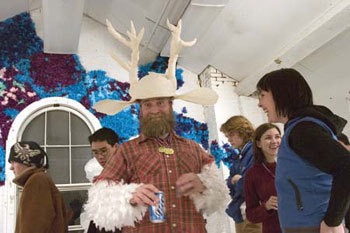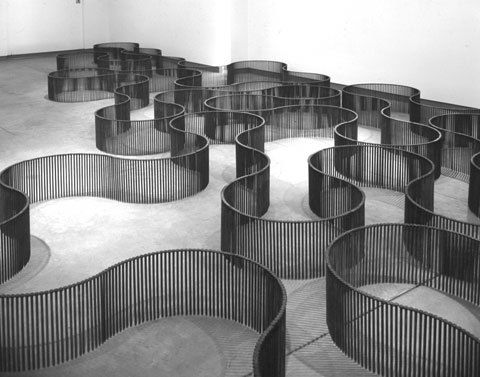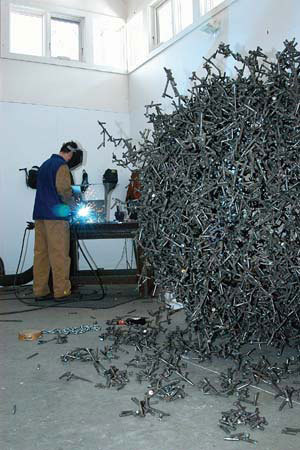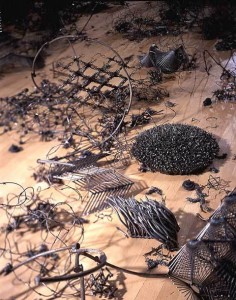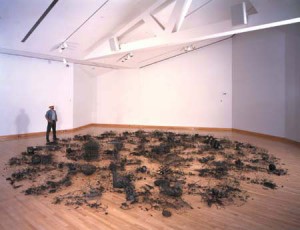Photos by James Marshall and Joanna Eldredge Morrissey.
People tend to think of artists in one of two ways: either they confuse them with their art, or they find them curiously unlike it. Sculptor John Bisbee is both.
His personality explodes with thorny contradictions like the large, mind-boggling installations he creates from 12-inch steel spikes, or nails. Sometimes his work, and life, unfold in highly disciplined explorations. Driven to dwell in the physicality of geometric form, Bisbee will spend hundreds of hours in his studio painstakingly welding spikes into repetitive shapes. They congeal into perfect spheres, or become triangles snaking across the floor in elegant ridges.
Other times, it’s as if he is obsessed with some secret molecular vision. The spikes cling to walls and floors in tangled clumps and loops. He amasses them in one space, only to reconfigure them another way in another site. However assembled, they have a certain perfection, giving the viewer the tantalizing feeling of having glimpsed and almost understood some basic substructure of the universe.
“While I’m working I fool myself into thinking I know where I’m going,” says Bisbee, “and from that point on it’s a cocktail of intensive labor and complete openness and waiting for that thing to happen ”
That “thing” is earning Bisbee a reputation as one of the most important sculptors working in New England today.
He has had solo exhibitions at the Albright-Knox Museum in Buffalo, at the Kemper Museum of Contemporary Art in Kansas City, and he has an upcoming solo show at the Portland Museum of Art in 2006.
Bisbee’s work is included in the collections of the Bowdoin College Museum of Art, the DeCordova Museum, The Albright-Knox Gallery, the Portland Museum of Art, at Microsoft, and in private collections. Reviews of his work have appeared in Art in America, ARTnews, Sculpture Magazine, The Boston Globe, The New Yorker and The New York Times.
MAN OR MOUSE?
Those who first encounter the Bowdoin adjunct art lecturer might not guess at the seriousness with which he approaches his work, or at the shyness his colorful personality almost masks.
There’s no doubt. Bisbee is quirky. Genuinely eccentric, and clearly delighted by the effects of his eccentricity, he routinely teaches classes with a pet mouse called Pepper tucked into his shirt pocket. (He rescued it as an orphan: “It was after a huge rain, after a party… and here was this little hairless wonder in the driveway.”)
Pepper’s existence is a matter of course for Bisbee’s Sculpture II students. They take no notice as he feeds Pepper smidgeons of Saltines and freewheels around the Adams Hall studio, looking at their work.
“There is a medal up for grabs today,” he shouts to no one in particular. He dangles a plastic dime store medallion inscribed “Winner,” and rocks back on his heels in exaggerated importance. “Pay attention! This is going to someone who deserves it.”
His students are unphased by this comic enticement, understanding perhaps that rewards will be won only after many hours of their labor.
There is Adrienne Heflich ’06, an environmental studies/digital art double-major. She sits hunched over a bench, painstakingly gluing together rings of potato chips. “It’s a materials study,” she says. “You just let the potato chips talk to you. It’s work and more work that builds up over time. That’s where creation comes from.”
Eric Diceron ’05 is applying layers of liquid latex to a plaster-cast finger. His idea at this stage is to create latex molds of various body parts and fill them with different kinds of food. “Cake frosting, Jello, sugar, butter – anything that will sort of keep its shape after you put it in the refrigerator and take it out of the mold,” he says. “You could eat my sculptures. I’ve never worked with latex before and it’s tough learning. This one alone will take me about 25 layers to make.”
This is a materials class, which means students will spend an entire semester discovering different ways of working with one material. Students choose their own material and Bisbee serves as part mentor, part technical advisor, as they explore the possibilities of their chosen medium.
“They are investigating and excavating,” says Bisbee. “It’s a matter of taking something and making it do something that it wouldn’t want to do. You’re going to start with the obvious, then work your way to the absurd. There is no thinking at this point; the answers will come.”
“I want them to not know what they’re doing — and to do something anyway and believe that through that activity something will be revealed.”
Bisbee bases much of his teaching on this concept of suspended thought. Creativity has nothing to do with being inspired, he argues. It comes from action.
“These kids are among the academic elite of the country and it’s wonderful to take those [thinking] skills away from them,” he laughs. “I want them to forget to use their analytical abilities. I want them to not know what they’re doing – and to do something anyway and believe that through that activity something will be revealed. I would say that almost always something is revealed. It can be really liberating and exciting for them.”
DEMON CHILD
Bisbee knows something about the tension between the creative impulse and traditional academic expectations. The child of academics, Bisbee grew up in Cambridge, Mass., and attended Milton Academy, where his father taught math. Creative, rebellious, athletic, and dyslexic, Bisbee struggled to find his place in the world.
“I was a demon child,” he smirks. “My parents kept saying, ‘He’s so bright; if he can just get those grades up…’ They were absolutely supportive, but they knew I wasn’t going to Harvard.”
Eventually he made it to Skidmore, got kicked out after one semester (“I never even registered for class”), then studied briefly at the Museum School of Fine Arts in Boston. After that he worked at a rock ‘n’ roll club in Boston and coached lacrosse at Milton, before enrolling at Alfred University, where he studied ceramics and glassblowing, and eventually, sculpture.
He gives the impression of having been a misfit even to himself: “I don’t think my clarity was so great at that time,” he says, eyes wandering. “Then I decided I was a sculptor. That was pretty much my birth.”
Bisbee credits his fellow sculpture students at Alfred with inspiring the work ethic that now underpins everything he does. They were deeply engaged in making art, he says. And, they were competitive.
“The measure of what kind of person you were there was what kind of work you were doing,” says Bisbee. “It was always ‘How’s the work?” They were deeply concerned about making good stuff. I come out of a background of sports and competition so I thought it was a nice dovetail.”
THE PIED PIPER EFFECT
Given his own academic travails, Bisbee’s subsequent teaching career might seem incongruous – or at least unlikely. It began by happy coincidence in 1995, when Visual Arts Department Chair Mark Wethli encountered Bisbee during an overlapping stay at the prestigious MacDowell art colony in New Hampshire.
“Like most people, my first encounter with John was, uh, striking,” says Wethli. “You know you’ve met someone out of the ordinary. I was certainly impressed with his art. It was clear he was doing something important that was all his own.”
More than that, Wethli saw in Bisbee’s personality and his work an approach that would electrify art making in a liberal arts setting. “I just intuited that he was a good fit for Bowdoin,” says Wethli. “I knew he had a kind of energy, enthusiasm and passion for what he did that our students would benefit from.”
He encouraged Bisbee to apply for an opening at Bowdoin for an adjunct lecturer in art – a misnomer if ever there was one (His lectures are more scolds, along the lines of avoiding flesh burns when using a hot glue gun.). He got the job and has remained at Bowdoin ever since, teaching Sculpture I and II for one semester, then working on his art the rest of the year.
Wethli was right about the Pied Piper effect Bisbee would have on Bowdoin students. One would be hard-pressed to find a past or present student who didn’t find Bisbee influential and inspiring, even if their interests ultimately carried them elsewhere.
“I wasn’t interested in art at all and I took John’s Sculpture I class and it totally opened me up, my whole perspective,” says Eric Diceron, whose latex exploration after several weeks has remained focused, after all, on the finger. It is a magnificent study of digits with a circle of latex fingers rising from the floor like spines. “I never took any art classes in high school; I really didn’t know what to expect.”
What he discovered, he says, was a newfound freedom to explore ideas and a growing confidence in his creative abilities. Diceron originally intended to major in the sciences, but became a visual arts major/biology minor after working with Bisbee. “It’s been great, that balance of art and science,” says Diceron. “I felt that the art, that creative aspect, would help me in all things.” True to the liberal arts dictum of preparing students for all paths in life, Diceron says he plans to become an investment banker after graduation.
“I think it’s just my frame of mind,” he says, adjusting the fingers. “I’m creative, and I like business. Working with art has taught me that you have to look at things through different angles.”
A majority of Bisbee’s students will move on to paths other than art, but there are those for whom the imprint of art making is indelible.
Bisbee can count among his faithful a string of Bowdoin alumni who are actively making their way in the art world. Among them are: Kyle Durrie ’01, a Portland-based artist and rising young star in the Maine art world; Mike Zachary ’02, a New Hampshire painter who is beginning to show in juried exhibitions; and Bryson Brodie ’00, a New York-based artist and co-director of the Plane Space art gallery in Manhattan with fellow Bowdoin alum Chad MacDermid ’00. (The pair represent Bisbee and often exhibit his works at Plane Space.)
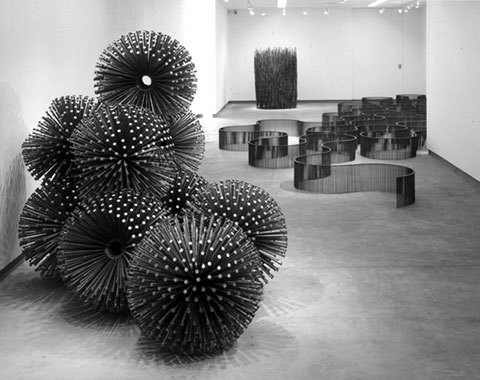 “What students get from John,” observes Mark Wethli, “is a sense of courage. Embarking on a path in art requires courage as much as talent or hard work. Unlike their classmates who are heading toward law or medicine or business, the path in the arts is not charted. That can be bewildering, and emotionally and economically challenging. John is a truth-teller, he will not sugar coat what lies ahead. He gives them a clear-eyed sense of what their life in art will probably entail, but by his own example makes it a compelling choice.”
“What students get from John,” observes Mark Wethli, “is a sense of courage. Embarking on a path in art requires courage as much as talent or hard work. Unlike their classmates who are heading toward law or medicine or business, the path in the arts is not charted. That can be bewildering, and emotionally and economically challenging. John is a truth-teller, he will not sugar coat what lies ahead. He gives them a clear-eyed sense of what their life in art will probably entail, but by his own example makes it a compelling choice.”One former student who appears to have taken Bisbee’s example to heart is Ben Butler ’00, a sculptor who is chiseling out a promising career in New York and has an upcoming show at the ZG Gallery in Chicago. “My being a sculptor came absolutely from working with John,” he says. “His single biggest influence was in not teaching me how to make art, but in teaching me how to be an artist.”
It is a distinction, he says, that began in the classroom and continues today. “He doesn’t give you any slack, and at the same time is very encouraging. He gives you the material and forces you to teach yourself. How to use your hands and how to manifest your idea physically. That’s how he makes his own work, he teaches by example.”
Bisbee claims that the guidance flows the other way, that it is the students who enrich him. “What they give to me is their youth and their discovery and surprise,” he says. “They have a liquidity and can pour themselves into different shapes. Just to have the gift of being able to watch this journey begin year after year, it’s an elixir. ”
FINALLY, THE ARTIST
It’s a vitality Bisbee misses after the semester ends, when the burden of being an artist rests on him … like a ton of nails. They are the moments when he struggles against what he calls “the Bisbeeness of it all.”

And there are personal costs. Phone calls remain unanswered as he retreats into work. He forgets to eat. Loved ones are left outside the studio door. “I’m so ‘mono-focular’ in my pursuit that my personal life is somewhat dysfunctional,” he acknowledges. “I don’t maintenance my life.”
Bisbee is somewhat fatalistic about it: “There’s nothing you can do about it. You work your ass off. That’s what it means to be serious. I’m in the studio day after day with nails and still seeing things I can get to. It’s infinite.”
Out of that infinite imagination, Bisbee is creating a mature body of work that magnetizes with its grace and strength. Early objects are highly organic, revealing traces of his earlier work as a ceramic artist. In the late 1980s, his first explorations with the nail birthed objects bordering on surrealism. Briefcase (1988), which the Bowdoin Museum of Art recently purchased, resembles a businessman’s briefcase, but, alarmingly, is wrought of nails, barbed wire, metal and wood.
“It appears to me that in making objects out of materials that tend to be disconcerting for the viewer, he achieves a kind of hard beauty, even if the thing itself isn’t lovely,” notes Dan O’Leary, director of the Portland Museum of Art. “The material used sometimes conflicts in a very interesting way with the thing that’s portrayed.”
As Bisbee began to push the medium, his explorations shifted from objects to large, site-specific installations. In Field (2000), created for the Kemper Museum of Contemporary Art in Kansas City, Bisbee covered the floor with evocative groupings of 16-inch nails. In an article for Sculpture Magazine, Bowdoin College Museum of Art Curator Alison Ferris observed that they “inspire all sorts of connotations: moss, fossils, shells, plankton, insects, termite mounds, and … funky cast-off pieces of manufactured parts from a local foundry. Field exemplifies Bisbee’s ability, through intense experimentation, to transform the ordinary into objects of wonder.”
The only drawback to Bisbee’s work, if there indeed is one, is that the sheer weight of his installations require walls and floors that can withstand its steel tonnage. It took an engineer and a full crew of Bowdoin facilites staffers to install Current (1999) on the wall of Druckenmiller Hall. In order to support the complex, interlocking four-foot panels of arcing nails, the wall had to be dismantled, structural steel added, and the whole wall rebuilt with 3/4-inch plywood and sheetrock.
One could argue that the monumentality of his work demands a venue of equal stature. Bisbee, however, is insistent that his work been seen in a wide assortment of venues. One of his favorite places to show is at Plane Space, the firehouse-turned-gallery, which he describes as ” a juggernaut of the New York art scene.”
It was his snaking piece, Rove (2002), which Bisbee created for Plane Space’s inaugural exhibition (and his New York debut), that earned him a rave in Art in America, where it was lauded as “exquisitely ornamental, like a florid calligraphic initial … the repetition of thousands of spikes and dozens of curves was mesmerizing.”
Made from vertical nails standing on point and welded at their heads, the sculpture snakes back and forth on itself in fluid ribbons. “I think it is really one of the most startlingly successful objects made by any sculptor of his generation,” says PMA Director Dan O’Leary. “When I saw it at his studio before it was even exhibited, I knew that John had risen to a level where there aren’t many other artists working.”
With trademark candor, Bisbee seems to agree with this assessment. When asked about the probability of having his work acquired by a top national museum, Bisbee says: “It’s inevitable. I’m not going to get worse. I’m definitely a big picture guy. The equation is pretty easy for me. Make few things of high quality… then good things will happen. They can’t not.”
As if emboldened by this statement, Pepper pops up from Bisbee’s shirt pocket and runs a quick lap around his shoulders. “Pepper! Pepper!” remonstrates Bisbee, vainly grabbing for him as he scampers through his beard and across his head. “We’ve talked about this. Don’t make me talk to you again!”
Pepper pays no attention. He makes one last loop, then hops back into Bisbee’s pocket, nestled against the artist’s heart.
